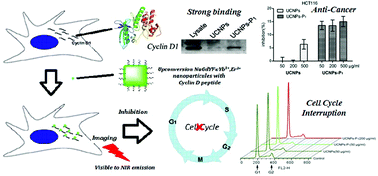Bifunctional up-converting lanthanide nanoparticles for selective in vitro imaging and inhibition of cyclin D as anti-cancer agents†
Abstract
Inhibition of the CDK4/cyclin D complex through the substrate recruitment site on the cyclin positive regulatory subunit is recognised as being a promising anti-cancer target. Specific peptide sequences can be used to selectively disrupt this target, but the development of peptides as anti-tumor agents in vitro/in vivo presents several obstacles. Poor cell internalization, low sensitivity towards enzymatic degradation in vivo, and ineffectiveness in monitoring via indirect screening are all issues which must be overcome. Herein, we describe the surface functionalization of lanthanide nanoparticles with cyclin D-specific peptides to prepare novel nanomaterials (UCNPs–P1) which can target the CDK4/cyclin D complex. The nanomaterials prepared (UCNPs–P1) are cell permeable and they display parallel emission spectra in vitro and in an aqueous biological environment. They can also be used in low dose concentrations under harmless NIR excitation and emission via upconversion. Uniquely, in addition to acting as a bioimaging probe, UCNPs–P1 also exhibits promising cytotoxicity towards cancer cells. In light of the aforementioned properties, the prepared functionalized nanomaterials (UCNPs–P1) offer the first real dual acting system for cyclin D imaging and simultaneous inhibition of cancer cell division.

- This article is part of the themed collection: JMC B Top Picks web collection: Seeing the unseen: Advances in bioimaging and biosensors

 Please wait while we load your content...
Please wait while we load your content...